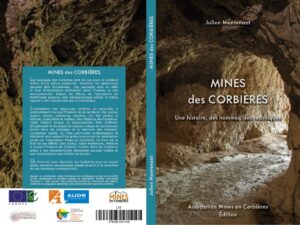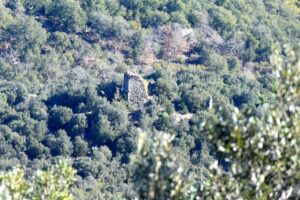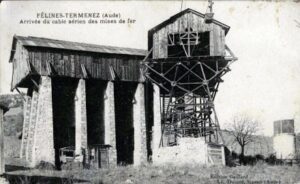 Mines des Corbieres, Une histoire, des hommes, des techniques by Julien Mantenant published by the Association Lines en Corbieres.
Mines des Corbieres, Une histoire, des hommes, des techniques by Julien Mantenant published by the Association Lines en Corbieres.
For an amateur local history buff like me the Mines of the Corbieres is a fascinating read that really gave me a deeper understanding of the history of the countryside of the Hautes Corbieres, the development of the villages, the castles, including our own Montrouch, and the huge impact of human activity on the natural environment.
There are to this day many signs that remain of the 2,000 years of mining in the Hautes Corbieres, from the remains of the forges, the tramways, old mining excavations, the rocky hillsides denuded of forest.
Mining in the Hautes Corbieres goes back to the Bronze age, It started with copper and silver, then as technology, particularly Metallurgy, developed, moved on to lead, iron, antimony, and magnesium.
It all started 500 million years ago. The movement of the tectonic plates that formed the mountains barrier of the Pyrenees, raised the sediments from the sea floor; The volcanic activity that heated up and liquefied the sediments causing them to flow in the fissures in the rock; The pressure that crushed the molecules together, and compressed the vegetation took millions of years to transform the elements onto metals. The time frame and forces involved in forming the metals is staggering to the human imagination.
The book, Mines des Corbieres traces back the history of mining in the Corbieres from the earliest traces, through Roman times, into the Medieval period right through to the start of the 21st Century when the last mine finally closed.
Mines in the Corbieres tracks the cycles of human activity that rose and fell depending on the technologies available at the time for the extraction, the processing and transformation of the ore into tools, arms, and money.
It is not a straight development line. In each of the four distinct periods of mining the available technologies determined the limits of what could be profitably exploited, and where it could be profitably exploited. As the relevant technologies,developed in the larger mining areas, were imported into the Corbieres, along with the men with the relevant expertise, and the available finance. Ore deposits that in a previously era could not be reasonably transformed became exploitable, but equally it faced a market where the richer areas, both in terms of money and deposits, offered up more fierce competition. As improved transport networks, lowered the cost of transport and opened up more markets, equally they exposed the Corbieres metals to national and international competitors.
As well as the metal deposits, two other key resources were necessary to transform the ore to viable metals, wood and water. A third, that of limestone flux grew in importance as technology for iron purification developed.
Mining and the transformation of the ore consume wood and water in huge quantities. Wood is essential, not just for pit props, but to provide the charcoal for the heat stages used in the iron transformation process, as well cooking limestone to maker flux.
Charcoal was also used in large quantities in the forges that repaired the miners tools, smelted the metals into bars for export, and crafted agricultural tools, arms, jewellery and money.
It is estimated that a forge a la catalan the cutting edge of ore transformation from the 17th century until the modern furnaces of the 19th  , if worked by two eight men crews 24 hours a day consumed 6,700 cubic metres of charcoal a year. There were four in the Hautes Corbieres, St Pierre des Champs, now the Fargo restaurant, another in Montguiard, that Brian and Eunice renovated into a three house hamlet, another in Palariac and a fourth in the gorge below Padern, which is in the process of being converted into a house. The largest was the Padern forge, at one moment in the mid 19th Century over 100 inhabitants of Padern worked either in the forge or as full time miners.
, if worked by two eight men crews 24 hours a day consumed 6,700 cubic metres of charcoal a year. There were four in the Hautes Corbieres, St Pierre des Champs, now the Fargo restaurant, another in Montguiard, that Brian and Eunice renovated into a three house hamlet, another in Palariac and a fourth in the gorge below Padern, which is in the process of being converted into a house. The largest was the Padern forge, at one moment in the mid 19th Century over 100 inhabitants of Padern worked either in the forge or as full time miners.
Water for washing the ore, and later for driving the hydrolytic mills was also essential,, which explains the locations of all four next to the major water courses of the Hautes Corbieres.
While the mines themselves were scattered across the hills of the Hautes and Basse Corbieres wherever exploitable deposits were found, the bloomeries, workshops, forges and mills were in the valleys were both wood and plentiful water was at hand.
Around the mines and the workshops a community of suppliers of raw materials existed, foresters, charcoal makes, muleteers for transporting the ore to the workshops, the charcoal ro the forges, the wood beams for the mine props, and exporting the metals. Specialist metallurgists were imported from Austria, Germany, Sweden and other mining areas of France to transformed the ore into metal. black smiths to repair tools and forge goods for local sales and exports, and of course the owners guards and overseers.
Human habitations and buildings also changed, miners built cabins and stone houses near to their exploitations, charcoal burners built kilns in the forests, as it was easier to transform the wood in place and transport the lighter charcoal.
As Medieval records of the state of the forests of the Corbieres are non existent the impact of the de forestation caused by the charcoal makers is unknown. The records that do exists indicate disputes between property owners, the key local players, the Lords of Thermes and Carcassonne and the Comte of Foix and the ecclesiastical large property owners of Lagrasse, Fontfrioide and the Archbishop of Narbonne over access to forests Indicating that the damage done by the wood cutters must have been substantial.
 Given the scale of mining in the Corbieres, the expansion of the local population with the migration of miners and their families the forest cleared would have freed up more land for cultivation, and created more pasture for livestock.
Given the scale of mining in the Corbieres, the expansion of the local population with the migration of miners and their families the forest cleared would have freed up more land for cultivation, and created more pasture for livestock.
In Peter McPhee Revolution and environment in Southern France the author identifies the key moment that accelerated the deforestation of the Hautes Corbieres as the French Revolution. McPhee argies that the long running battle conflict of the peasants to expand their cultivated and, cut wood and graze animals was held in abeyance by the land owning aristocracy, the fall of the Monarchy and the rise of the urban bourgeois to state power saw the power of the aristocracy decline; and with it their ability to prevent land encroachment.
What Mines des Corbieres explains is that the 17th Century saw a concerted effort by the French state to develop the mining activity in the Hautes Corbieres. The formation of the Compagnie royale des Mines et founderies du Languedoc, 1666-1671 under the guide of Colbert’s agent, Cesar d’Arcons brought together many of the Languedoc’s major rich families to pour money into expanding both the lines and the forges that transformed the ore. Incidentally these were the same investors who lost a fortune funding the Canal de Midi. It was during this period that the four forge a la catalan were built. So rather than the local aristocracy holding back de forestation, it was these large land owners who were actually investing in the key technologies that accelerated the decimation of the forests of the Hautes Corbieres.
Mines des Corbieres is a fascinating study of the history of the mines of the Hautes Corbieres and their role in fashioning the villages and countryside of the area.
You can buy a copy online from B and C Epicerie in Laroque de Fa Here
The Association Lines en Corbieres holds annual events and tours around the sites of the mines.
